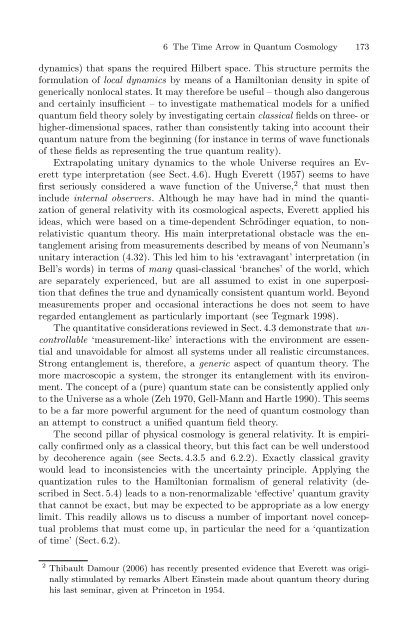The Physical Basis of The Direction of Time (The Frontiers ...
The Physical Basis of The Direction of Time (The Frontiers ...
The Physical Basis of The Direction of Time (The Frontiers ...
Create successful ePaper yourself
Turn your PDF publications into a flip-book with our unique Google optimized e-Paper software.
6 <strong>The</strong> <strong>Time</strong> Arrow in Quantum Cosmology 173<br />
dynamics) that spans the required Hilbert space. This structure permits the<br />
formulation <strong>of</strong> local dynamics by means <strong>of</strong> a Hamiltonian density in spite <strong>of</strong><br />
generically nonlocal states. It may therefore be useful – though also dangerous<br />
and certainly insufficient – to investigate mathematical models for a unified<br />
quantum field theory solely by investigating certain classical fields on three- or<br />
higher-dimensional spaces, rather than consistently taking into account their<br />
quantum nature from the beginning (for instance in terms <strong>of</strong> wave functionals<br />
<strong>of</strong> these fields as representing the true quantum reality).<br />
Extrapolating unitary dynamics to the whole Universe requires an Everett<br />
type interpretation (see Sect. 4.6). Hugh Everett (1957) seems to have<br />
first seriously considered a wave function <strong>of</strong> the Universe, 2 that must then<br />
include internal observers. Although he may have had in mind the quantization<br />
<strong>of</strong> general relativity with its cosmological aspects, Everett applied his<br />
ideas, which were based on a time-dependent Schrödinger equation, to nonrelativistic<br />
quantum theory. His main interpretational obstacle was the entanglement<br />
arising from measurements described by means <strong>of</strong> von Neumann’s<br />
unitary interaction (4.32). This led him to his ‘extravagant’ interpretation (in<br />
Bell’s words) in terms <strong>of</strong> many quasi-classical ‘branches’ <strong>of</strong> the world, which<br />
are separately experienced, but are all assumed to exist in one superposition<br />
that defines the true and dynamically consistent quantum world. Beyond<br />
measurements proper and occasional interactions he does not seem to have<br />
regarded entanglement as particularly important (see Tegmark 1998).<br />
<strong>The</strong> quantitative considerations reviewed in Sect. 4.3 demonstrate that uncontrollable<br />
‘measurement-like’ interactions with the environment are essential<br />
and unavoidable for almost all systems under all realistic circumstances.<br />
Strong entanglement is, therefore, a generic aspect <strong>of</strong> quantum theory. <strong>The</strong><br />
more macroscopic a system, the stronger its entanglement with its environment.<br />
<strong>The</strong> concept <strong>of</strong> a (pure) quantum state can be consistently applied only<br />
to the Universe as a whole (Zeh 1970, Gell-Mann and Hartle 1990). This seems<br />
to be a far more powerful argument for the need <strong>of</strong> quantum cosmology than<br />
an attempt to construct a unified quantum field theory.<br />
<strong>The</strong> second pillar <strong>of</strong> physical cosmology is general relativity. It is empirically<br />
confirmed only as a classical theory, but this fact can be well understood<br />
by decoherence again (see Sects. 4.3.5 and 6.2.2). Exactly classical gravity<br />
would lead to inconsistencies with the uncertainty principle. Applying the<br />
quantization rules to the Hamiltonian formalism <strong>of</strong> general relativity (described<br />
in Sect. 5.4) leads to a non-renormalizable ‘effective’ quantum gravity<br />
that cannot be exact, but may be expected to be appropriate as a low energy<br />
limit. This readily allows us to discuss a number <strong>of</strong> important novel conceptual<br />
problems that must come up, in particular the need for a ‘quantization<br />
<strong>of</strong> time’ (Sect. 6.2).<br />
2 Thibault Damour (2006) has recently presented evidence that Everett was originally<br />
stimulated by remarks Albert Einstein made about quantum theory during<br />
his last seminar, given at Princeton in 1954.



![arXiv:1001.0993v1 [hep-ph] 6 Jan 2010](https://img.yumpu.com/51282177/1/190x245/arxiv10010993v1-hep-ph-6-jan-2010.jpg?quality=85)


![arXiv:1008.3907v2 [astro-ph.CO] 1 Nov 2011](https://img.yumpu.com/48909562/1/190x245/arxiv10083907v2-astro-phco-1-nov-2011.jpg?quality=85)








![arXiv:1002.4928v1 [gr-qc] 26 Feb 2010](https://img.yumpu.com/41209516/1/190x245/arxiv10024928v1-gr-qc-26-feb-2010.jpg?quality=85)
![arXiv:1206.2653v1 [astro-ph.CO] 12 Jun 2012](https://img.yumpu.com/39510078/1/190x245/arxiv12062653v1-astro-phco-12-jun-2012.jpg?quality=85)
